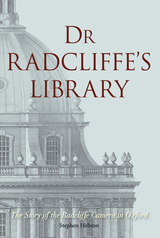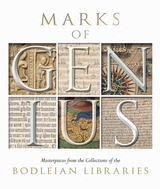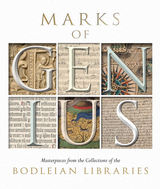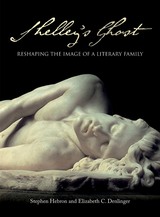
Drawing on maps, plans, photographs, and drawings, Dr Radcliffe’s Library tells the fascinating story of the building’s creation over more than thirty years. Early designs for the Radcliffe Camera were drawn by the brilliant architect Nicholas Hawksmoor, who conceived the shape so recognizable today: a great rotunda topped by the University of Oxford’s only dome. From there, it would take decades to acquire and clear the site between the University Church of St Mary’s and the Bodleian. After Hawksmoor’s death, the project was taken on by the Scottish architect James Gibbs who refined the design and supervised the library’s construction.
Published to accompany an exhibition opening in November at the Bodleian Library, Dr Radcliffe’s Library tells the fascinating story of the making of this architectural masterpiece.

Marks of Genius pays tribute to some of the most remarkable testaments to genius throughout human history, from ancient texts on papyrus and the extraordinary medieval manuscript The Douce Apocalypse to the renowned children’s work The Wind in the Willows. Bringing together some of the rarest and most impressive treasures in the collections of the Bodleian Libraries, it tells the story of each work’s creation and its journey through time, offering insight into the breadth and depth of its influence as well as and its power to fascinate.
Published to accompany an exhibition of the same name at the Morgan Library and Museum in New York, Marks of Genius celebrates with two hundred full-color illustrations works that constitute the pinnacle of human creativity and which we continue to restore and revisit—perhaps in the hopes that some of their remarkable brilliance will rub off.

Marks of Genius pays tribute to some of the most remarkable testaments to genius throughout human history, from ancient texts on papyrus and the extraordinary medieval manuscript The Douce Apocalypse to the renowned children’s work The Wind in the Willows. Bringing together some of the rarest and most impressive treasures in the collections of the Bodleian Libraries, it tells the story of each work’s creation and its journey through time, offering insight into the breadth and depth of its influence as well as and its power to fascinate.
Published to accompany an exhibition of the same name at the Morgan Library and Museum in New York, Marks of Genius celebrates with two hundred full-color illustrations works that constitute the pinnacle of human creativity and which we continue to restore and revisit—perhaps in the hopes that some of their remarkable brilliance will rub off.

It is difficult to think of a family more endowed with literary genius than the Shelley family—from the Romantic poet Percy Bysshe Shelley and his wife, novelist Mary Shelley, to Mary’s parents, William Godwin and Mary Wollstonecraft—all were authors in their own right. Using extensive archival material, Shelley’s Ghost explores the making of this remarkable literary family’s reputation.
Drawing on the Bodleian Library’s outstanding collection of letters, poetry manuscripts, rare printed books, portraits, and other personalia—including Shelley’s working notebooks, Keats’s letters to Shelley, William Godwin’s diary, and the original manuscript of Mary Shelley’s Frankenstein—Stephen Hebron charts the history of this talented yet troubled family. After Percy Bysshe Shelley’s drowning in 1822, Mary published various manuscripts relating to both her husband’s and her father’s lives, and passed this historical legacy to her son, Sir Percy Florence Shelley and his wife, Lady Jane Shelley. As guardians of the archive until they bequeathed it to the Bodleian in 1892, Sir Percy Florence and Lady Jane helped shape the posthumous reputations of these writers. An afterword by Elizabeth Denlinger of the New York Public Library offers an additional perspective, exploring material relating to the Shelley family that slipped beyond the family’s control.
An unparalleled look at one of the most significant families of British Romantic literature, Shelley’s Ghost will be welcomed by scholars and the many fans of this enduring literacy legacy.
READERS
Browse our collection.
PUBLISHERS
See BiblioVault's publisher services.
STUDENT SERVICES
Files for college accessibility offices.
UChicago Accessibility Resources
home | accessibility | search | about | contact us
BiblioVault ® 2001 - 2024
The University of Chicago Press









